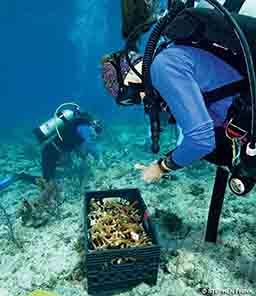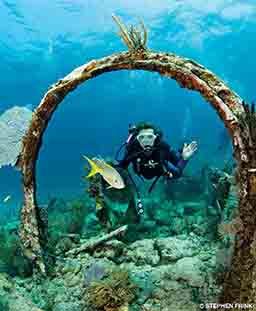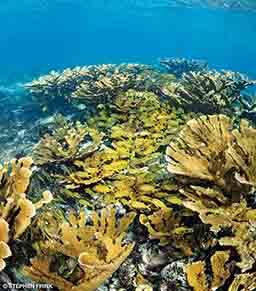On Saturday, June 9, 2018, blue-clad masses of people all around the globe will march in celebration of World Oceans Day. In Washington, D.C., the March for the Ocean will feature an armada (of kayaks, dragon boats and more) on the Potomac River and an exhibit of marine debris on the National Mall. The Washington Monument stage area will host a life-size blue whale exhibit. The 91-foot model of the largest animal to ever live on Earth will symbolize both the challenges facing our blue world and the wonder it inspires. Similar events will take place from Poland to Palau.
In Florida’s Key Largo and Key West, hundreds of volunteer divers with the Coral Restoration Foundation will hold a Dive for the Ocean, and San Francisco Bay will host a march and Swim for the Ocean. Healthy Ocean and Clean Water for All paddles will take place on three reservoirs outside Boulder, Denver and Greeley, Colorado. Those who care about the future of the ocean are taking the opportunity to let our fellow citizens and elected officials know that our living seas are at serious risk but that it’s not too late for them if we act together. March organizers conceptualize the event as an Earth Day for the ocean.
The U.S. Department of the Interior’s plans to open more than 90 percent of our public seas to oil leasing while also reducing safety rules established after the 2010 BP Deepwater Horizon disaster in the Gulf of Mexico have potentially monumental consequences. Another proposal is to either shrink the size of some marine monuments and sanctuaries or eliminate regulations that prohibit activities that are detrimental to the marine ecosystem. Concerns over environmental damage, including the danger of oil spills, have resulted in growing bipartisan opposition to the plans in California, Florida, South Carolina and New Jersey.
Learn More
For more information or to join the march, visit MarchfortheOcean.org.
“We have a chance now as never before to go from where we are to a much better, bluer place,” says ocean explorer and march speaker Sylvia Earle, Ph.D. “Protecting the ocean really means protecting everything we care about. Now is the time; we may never again have an opportunity like this.” Other notable divers who will be marching include environmental advocate Philippe Cousteau Jr., journalist Ashlan Gorse Cousteau, National Geographic Pristine Seas Director Enric Sala and the marine artist Wyland.

The average diver brings a variety of motivations for marching. When I was a kid I loved going to the beach but would look up at the stars and worry I was born too soon to explore other worlds. When I was 15, my mom took my sister and me to Key West; I put on a mask and snorkel and swam off the sea wall. Discovering colorful living rocks and shoaling fish and encountering my first sea turtle and hammerhead shark, I realized there is another world to explore — an entire alien world right off our shores.
Unfortunately, in my lifetime the Florida Keys reef line has gone from more than 90 percent to less than 10 percent live coral cover, with elkhorn and staghorn corals now classified as threatened under the Endangered Species Act. I saw my first bleached coral while diving in Fiji in 2001. In 2015 I saw more bleaching on the big island of Hawaii at the start of the third global bleaching event. Those three years (2015-2017), the three hottest in recorded history, gravely affected half the world’s coral, as documented in the film Chasing Coral.

Coral bleaching is just one of the problems our ocean is facing. Rising sea levels threaten coastal communities, and industrial overfishing and pirate (illegal, unreported and unregulated) fishing are leading to diminished populations of fish species on which humans rely for food.
Pollution from oil, plastic and chemicals affect the basic chemistry of the ocean — as does climate change. Scientists are now observing acidification of the ocean, which eliminates habitats and makes it harder for shell-forming creatures — from plankton to clams to corals — to build their skeletal homes. A warmer, more acidic ocean also holds less dissolved oxygen, which means more dead zones and fewer fish and plankton, certain species of which provide significant atmospheric oxygen.

We know what the solutions are: better fisheries management, less plastic waste, a job-generating clean energy revolution and more large marine protected areas or national parks in the sea that can act as biological reserves for sea life (while providing the best dive sites on the planet).
This is why the solution-oriented March for the Ocean has received such diverse support from divers, surfers, businesses, scientists, artists, musicians, explorers and concerned communities everywhere. Along with environmental groups such as the Sierra Club, Surfrider Foundation, Earth Day Network and the Ocean Conservancy, the march’s more than 100 partners to date include the Professional Association of Diving Instructors (PADI), Divers Alert Network (DAN), Ocean First Divers, the Monterey Bay Aquarium, the Pacific Coast Federation of Fishermen’s Associations and Boeing’s Liquid Robotics.
But the march’s real impact will come from its grassroots — people who get so much from the ocean that they want to give something back. Wearing blue and marching with friends and family on June 9 can make a difference and be fun as well. As Isak Dinesen wrote, “I know of a cure for everything: salt water … in one way or the other. Sweat, or tears, or the salt sea.”
| © Alert Diver — Q2 2018 |